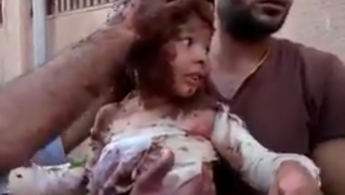Syrian infant burned by napalm, treated with mud
A film has emerged from Homs showing desperate medics treating a Syrian toddler writhing in agony with mud, in an attempt to cool the wounds following an incendiary bomb attack.
2 min read
The child had his wounds treated with mud by medics [Homs Media Centre]
A film has emerged showing a Syrian infant badly injured by an incendiary bomb having his wounds treated with mud.
The toddler shakes in pain as he is held by a man who without any medical equipment, has to tend to burn wounds with mud.
The boy was said to have been hurt by a napalm-like incendiary projectile in Homs, believed to have been fired from a mortar.
"After the bombing by war planes stopped, they began firing napalm," a doctor said, according to al-Jazeera. "Some of the patients were burnt."
The boy is in agony as bandages are unpeeled and mud packed onto the burns in an attempt to relieve the pain.
Hamzah, a four-year-old boy, and Ayah, a seven-month-old baby, were also burned to death in the attack, local sources told al-Jazeera.
Al-Waer, where the killings took place, is a rebel-held district of Homs.
It has been under siege for three years and one of the worst-hit parts of the country, largely ravaged by constant regime bombardment.
Food has run desperately low and medics have been left with little to treat the injured.
Russia and the Syrian regime have been accused of using incendiary bombs on civilian areas.
Human Rights Watch said footage from Syria had shown both Russia and the regime using napalm-like weapons on opposition areas.
The group documented 18 cases of such attacks in Aleppo and Idlib between 5 June and 10 August, and noted that the use of incendiary bombs by these forces was increasing.
"The Syrian government and Russia should immediately stop attacking civilian areas with incendiary weapons," said Steve Goose, arms director at Human Rights Watch.
"These weapons inflict horrible injuries and excruciating pain, so all countries should condemn their use in civilian areas."
The toddler shakes in pain as he is held by a man who without any medical equipment, has to tend to burn wounds with mud.
The boy was said to have been hurt by a napalm-like incendiary projectile in Homs, believed to have been fired from a mortar.
"After the bombing by war planes stopped, they began firing napalm," a doctor said, according to al-Jazeera. "Some of the patients were burnt."
The boy is in agony as bandages are unpeeled and mud packed onto the burns in an attempt to relieve the pain.
Hamzah, a four-year-old boy, and Ayah, a seven-month-old baby, were also burned to death in the attack, local sources told al-Jazeera.
Al-Waer, where the killings took place, is a rebel-held district of Homs.
It has been under siege for three years and one of the worst-hit parts of the country, largely ravaged by constant regime bombardment.
Food has run desperately low and medics have been left with little to treat the injured.
Russia and the Syrian regime have been accused of using incendiary bombs on civilian areas.
Human Rights Watch said footage from Syria had shown both Russia and the regime using napalm-like weapons on opposition areas.
The group documented 18 cases of such attacks in Aleppo and Idlib between 5 June and 10 August, and noted that the use of incendiary bombs by these forces was increasing.
"The Syrian government and Russia should immediately stop attacking civilian areas with incendiary weapons," said Steve Goose, arms director at Human Rights Watch.
"These weapons inflict horrible injuries and excruciating pain, so all countries should condemn their use in civilian areas."





 Follow the Middle East's top stories in English at The New Arab on Google News
Follow the Middle East's top stories in English at The New Arab on Google News
![Both Hamas and the Palestinian Authority welcomed the ICC arrest warrants [Getty]](/sites/default/files/styles/image_330x185/public/2024-11/GettyImages-2178351173.jpg?h=199d8c1f&itok=TV858iVg)

